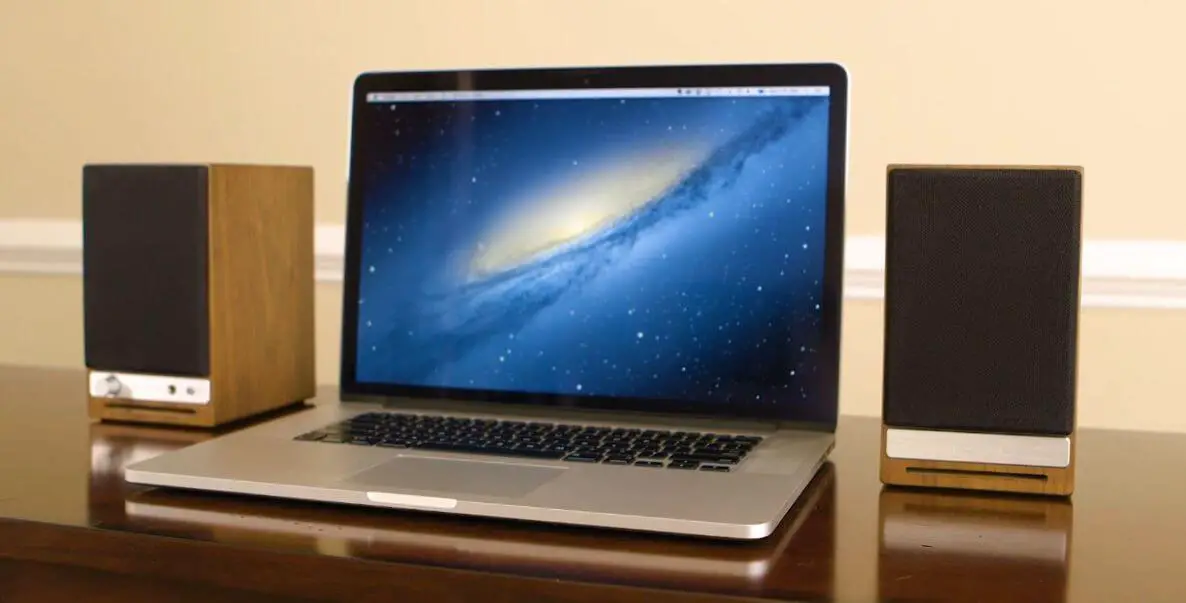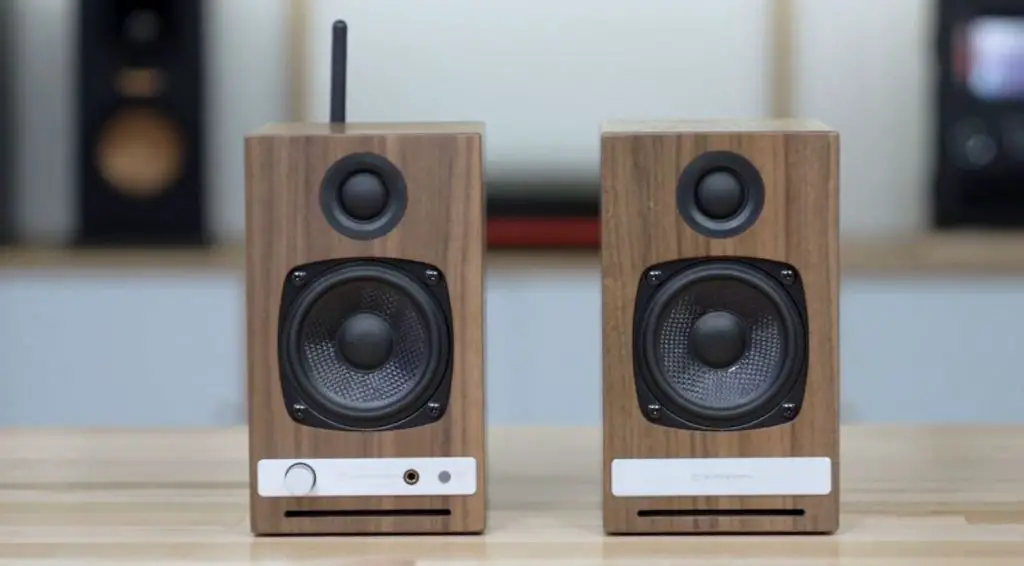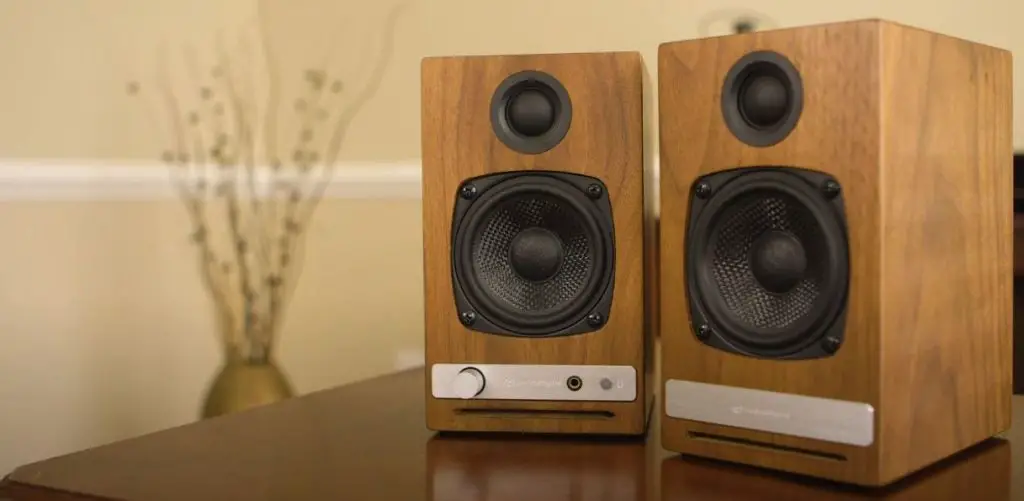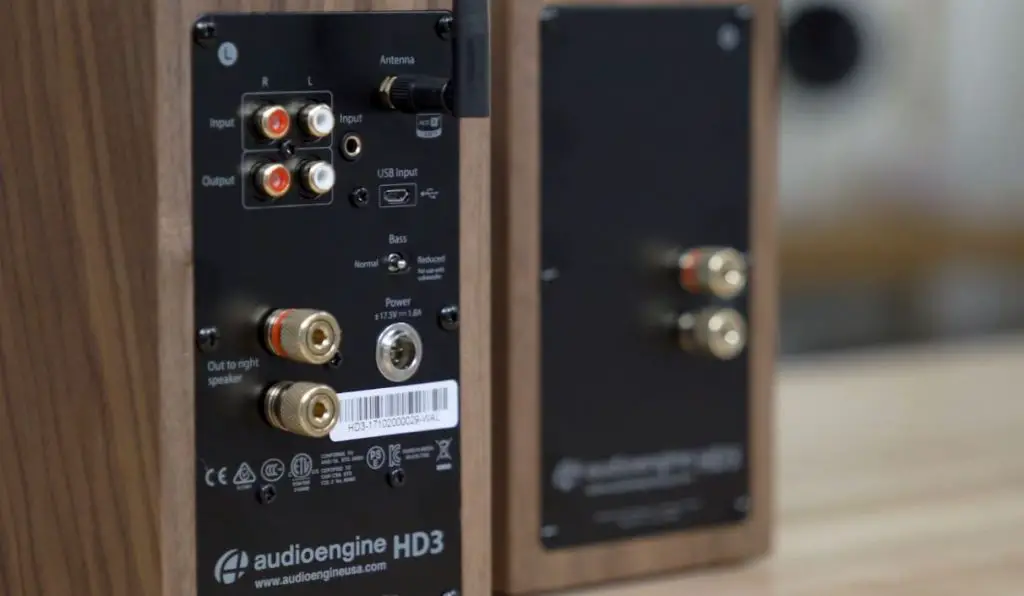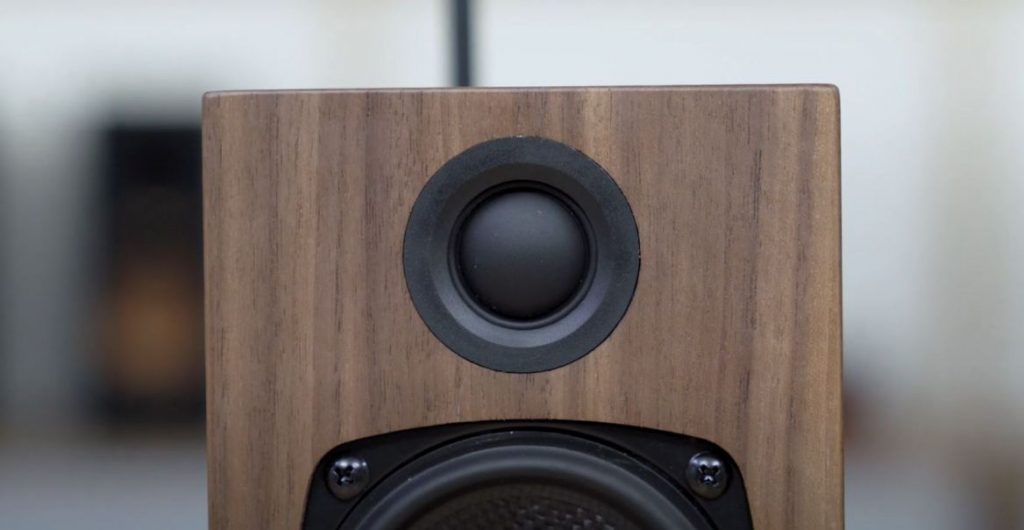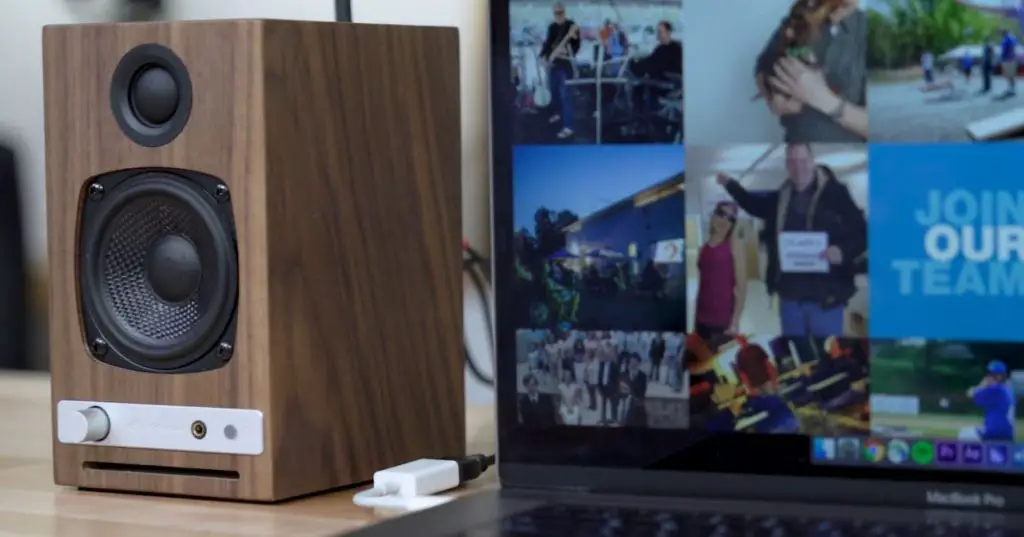Audioengine HD3 Review
This post will introduce Audioengine HD3 wireless speakers from the United States. This is a 3-inch desktop speaker. What kind of feelings can it bring to us? Let’s take a look together. Audioengine HD3 is a brand new flagship mini music system. Before using Audioengine HD3, I have experience with Audioengine products in A2+ and A5+, so I am quite familiar with Audioengine. If the appearance of Audioengine A2+ and A5+ gives you a bright feeling, then this HD3 makes you feel a strong retro style.
Audioengine HD3 desktop speaker has a very small size. The size of a single speaker is only 17.8cm x 10.8cm x 13.9cm, which is a desktop product more suitable for computers or notebooks. The size is similar to ordinary 2.0 multimedia speakers. The difference is that Audioengine HD3 is also a high-fidelity bookshelf speaker, which is aimed at music lovers or audiophiles. Therefore, most of the highlights are in styling and sound. Product accessories include a power adapter, speaker cable, USB cable, Bluetooth antenna, and 3.5mm audio cable.
A Brief History about Audioengine
The American audio brand Audioengine has a high reputation in North America and has been widely recognized by European and American users. Many of its products have a very good reputation. Many speakers have also won the authoritative magazine “What HI-FI” Five-star recommendation. Among them, Audioengine’s HD series of diversified connection methods can cooperate with various audio equipment, defining a new standard for small mini music systems.
Design
Among the loudspeaker products of many brands, Audioengine’s sense of design and quality is undoubtedly very prominent. And HD3 also continues Audioengine’s consistently high-level design. Not only is it calm and low-key, but it can also be easily integrated into any home improvement style.
Audioengine HD3 wireless speaker provides three finishes design of Satin Black, Walnut, and Hi-Gloss White, which seem to be more upscale, providing a wide range of possibilities for complementary matching of room furniture.
Audioengine HD3 computer speaker uses a 20mm wire dome tweeter, which gives people the overall feeling of retro and surging passion. The tweeter uses neodymium magnets. The powerful magnetic force of neodymium magnets is unmatched by traditional ferrite magnets. The better the magnetic density, the better the sound control. Of course, the cost is expensive. Of course, it can be replaced with ordinary ferrite, and the cost will be much lower. But for a speaker, the true sound expression is the soul. HD3 did not succumb to this.
The bass unit uses Kevlar composite material, which is a 2.75-inch Kevlar bass unit. The biggest advantage of Kevlar is that the material is light and strong and not easily deformed.
The specially designed magnetic grille of HD3 can be firmly attached to the front panel of the speaker to hide the speaker for a more concise look and feel. It can also protect the speaker unit without diffracting or scattering the sound.
Audioengine HD3’s cabinet design, driver unit, power amplifier, and passive crossover are all tailored and deployed. This makes the system perform better and is more energy-efficient than passive speakers and independent power amplifiers. The built-in power amplifier is placed in the left cabinet, users no longer need to connect the HD3 to a stereo receiver or an external power amplifier, which can save a lot of space for the entire system. HD3 uses the traditional full-analog Class AB design to provide superior sound quality and smoother sound.
Connections
Audioengine HD3 provides more ways to access audio sources. Wireless Bluetooth, USB, RCA, almost include all current mainstream access methods. And HD3 built-in B1 Bluetooth audio receiver and D1 decoder, equipped with aptX Bluetooth audio coding technology. Simply understand that it can re-encode audio files, compress the audio data packets during transmission, and then restore them at the receiving end, without affecting the sound quality, and achieving high fidelity after wireless transmission.
On the Bluetooth device, an external Bluetooth antenna is installed to enhance the transmission signal. A better channel and a more reliable wireless connection can play with better fidelity and provide higher quality sound.
In terms of interface, the Audioengine HD3 interface is quite rich. The main interface extensions are on the main speaker. It includes two sets of AUX interface, USB interface, power connector, Bluetooth antenna terminal. There is also a special external subwoofer adjustment switch, This is a rarely seen feature. The default is to turn on the bass (normal), and the bass effect of the HD3 main speaker can be weakened when the subwoofer is connected. But this is not completely closed, the effect is quite good in experience.
There is a volume knob on the front of the HD3 main speaker, which is also a speaker switch. On the right side, there is a 3.5mm headphone jack. Don’t underestimate this headphone jack. HD3 has a built-in low-noise op-amp based on OPA2134. The built-in amplifier does not need to use the ordinary sound card that comes with the computer motherboard, allowing you to directly obtain the highest quality enjoyment. If you don’t want to be noisy, you can directly connect headphones to enjoy the independent music world. The built-in OPA2134-based low-noise operational amplifier can make your music enjoyable without any compromise.
On the side of the 3.5mm, the headphone jack is a Bluetooth button. The advantage of Bluetooth mode is that you want to share the music on your phone and listen to it with others. At this time, a Bluetooth connection is the most pleasing way.
Powerful Decoding and High-quality Wireless Transmission
In addition to the functions of traditional active speakers, HD3 also integrates the features of Audioengine’s two best-selling products B1 Bluetooth audio receiver and D1 decoder to create a complete set of high-end analog and digital audio systems. In terms of decoding, the Audioengine HD3 speaker uses PCM5102 DAC. It has excellent signal-to-noise ratio specifications and can perform lossless conversion of digital signals, and supports up to 24bit/48Khz digital audio file decoding.
In terms of wireless transmission, HD3 supports aptX Bluetooth audio coding technology. Compared with most Bluetooth multimedia speakers, HD3 can provide higher-quality sound, so that Bluetooth can truly hear lossless sound quality, and it is also compatible with other Bluetooth devices. Of course, to get the best experience, the user’s audio source device also needs to support Bluetooth aptX technology. After installing the Bluetooth antenna in the speaker, the common problem of the limited use range of most Bluetooth products can be solved, so that the use distance of multiple rooms can be obtained without loss of sound quality.
Sound Performance
Through the Bluetooth input, the high-frequency performance of Audioengine HD3 is very good. Bright and thorough, with strong penetrating power, but without any burr. The sound is transparent, and the details and positioning are very clear and accurate. When replaying the vocals, Audioengine HD3’s sound is round, full, and natural, with clear details and full vocals. The combination of treble and bass is very good, and the connection of the whole high/mid/bass is very smooth. I especially like listening to the audition clips of the piano solo. The consistency of the matching of the tweeter and the woofer makes the sound field wide and profound.
Listening to the cello and piano song, the low frequencies of both instruments are very deep. However, Audioengine HD3 can still easily deconstruct the musical lines and low-frequency extensions of two different instruments in the bass area, faithfully reproducing the sense of scale and stability in this piece of music, presenting the physical sense of piano and cello. Audioengine HD3 can show a very clear image contour and graininess of the touch keys. In terms of sound quality, it can take into account the high-density smooth texture and the balanced distribution of the three frequency bands of high, middle, and low.
Finally, I especially listened to the USB input and played 24bit/96kHz high-format files through Foobar2000 of Windows system. Whether it is resolution, detail, density, and dynamics, there is a qualitative leap, and the amount of information is even more abundant! This is due to the built-in DAC module technology of Audioengine HD3. Therefore, the advantage of HD3 is that it can be played to the fullest in the playback of high-format files, which is a guarantee of high-quality sound.
Conclusion
Although Audioengine HD3 is positioned as a desktop-level small speaker, in the experience, it is obvious that what HD3 wants to express is: small size, big experience.
I originally thought that the main focus of HD3 was bass, and I was worried that the bass would be modified and the real experience of other frequency bands would be lost. After the actual audition, I felt that HD3 turned on the bass mode and did not suddenly increase the bass, but consciously increased the bass by 2 to 3 orders of magnitude from the original pure sound while maintaining a faster low-frequency response speed and elasticity.
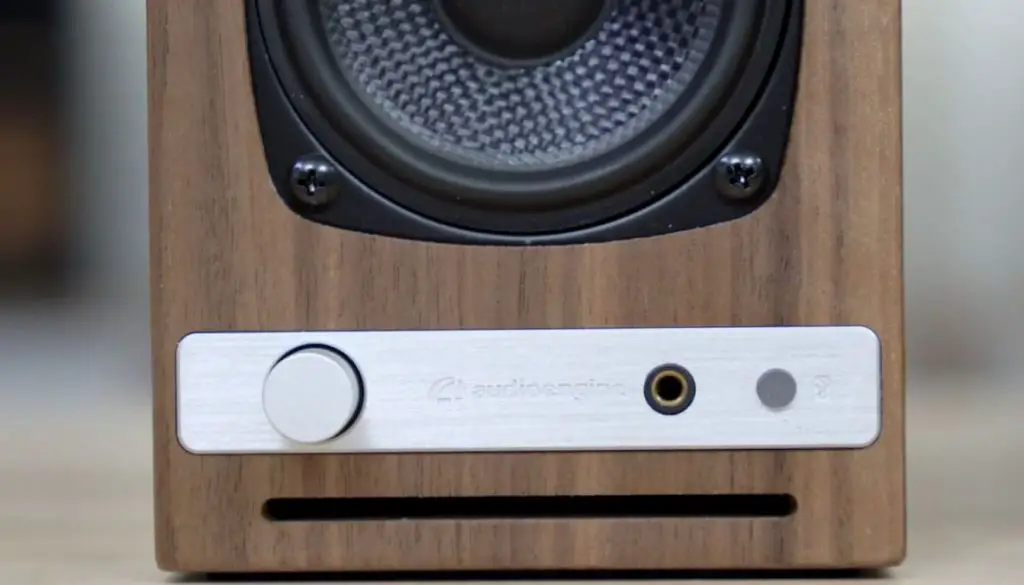
Secondly, HD3 gives me the feeling that mid-to-high frequencies have their characteristics. The 20mm silk dome high-frequency unit has been experienced on A2+ for a long time, so I did not think that there will be a bigger surprise on HD3, but it is not the case. HD3’s treble performance is more prominent, more delicate, textured, and has better penetration. . With a few songs in my ears, I have long forgotten that this is just a desktop speaker, which is completely integrated into this comfort.
Audioengine HD3 speaker is a success, a desktop speaker can integrate so many hardware, and at the same time complement each other in sound expression, the effect presented is intoxicating.
Audioengine HD3 Specs
- Type: Powered Bluetooth aptX HD speaker system
- Amplifier Type: Class AB
- Power Output: 61 W peak power total (15 W RMS / 30 W peak per channel), AES
- Drivers: 2.75” aramid fiber woofers, 0.75“ Silk dome tweeters
- Inputs: 3.5 mm stereo mini-jack, RCA L/R, USB, Bluetooth
- Outputs: RCA variable line-out, 3.5 mm mini-jack headphone out
- Input Voltages: 110-240 V 50/60 Hz auto-switching
- SNR: >95 dB (typical A-weighted)
- THD+N: <0.05% at all power settings
- Crosstalk: <50 dB
- Frequency Response: 65 Hz-22 kHz ±2.0 dB
- Input Impedence: 5K ohms unbalanced
- Protection: Output current limiting, thermal over-temperature, power on/off transient protection
- Power Consumption: Idle: 10W
